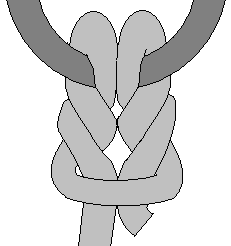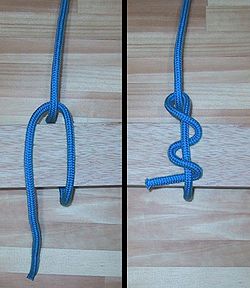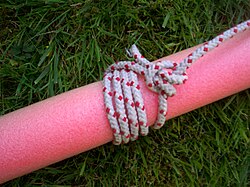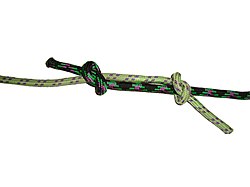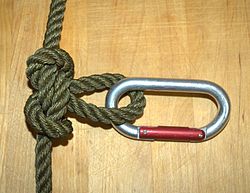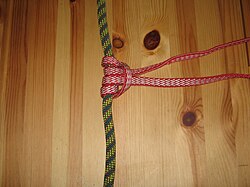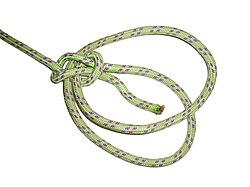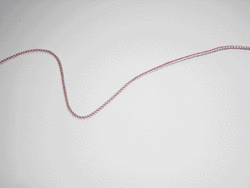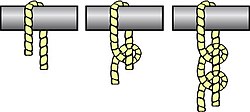Translations:Investiture Achievement/Companion/Outdoor Living/5/en
And here are the knots
| Constrictor Knot |
|---|
|
Use: The Constrictor knot is one of the most effective binding knots. Simple and secure, it is a harsh knot which can be difficult or impossible to untie once tightened. It is made similarly to a clove hitch but with one end passed under the other, forming an overhand knot under a riding turn. Because this knot will not slip when tied around a stick, it is an excellent knot for making a rope ladder.
How to tie:
WARNING: The Constrictor knot's severe bite, which makes it so effective, can damage or disfigure items it is tied around.
|
| Cat's paw |
|---|
|
Use: The Cat's paw is used for connecting a rope to an object.
How to tie:
Form a bight in the middle of the line, and pull it back over itself like a girth hitch. This forms two loops, turned in opposite directions. Give each loop one more full turn in the direction that will tend to tighten it (the wrong direction will undo the loop completely). Pass both loops over the hook, rail or post and pull tight, taking care to push the bight up snugly against the turns.
If working end of the line has an eye in it, and the standing end is accessible, the knot can be tied to a closed ring, another eye, or a rail with inaccessible ends, as follows. Pass the eye around the ring or rail, then pass the standing end through its own eye (this effectively forms a girth hitch). Then pass the standing end through the eye again, and pull up tight, taking care to push the bight up snugly against the turns. When using the cat's paw to join two eyes, this process may be repeated several times to give several turns - as many as five in a fine fishing monofilament. Then when tightened, instead of pulling the bight up against the turns, both eyes are pulled equally, to make neat coils of turns in both eyes, meeting halfway between them. |
| Timber hitch |
|---|
|
Use: The timber hitch is a knot used to attach a single length of rope to a piece of wood. This knot is easily undone after use.
How to tie:
|
| Pipe hitch |
|---|
|
Use: The pipe hitch is used for hoisting tubular objects (such as pipes).
How to tie:
|
| Fisherman's knot |
|---|
|
Use: The Fisherman's knot is a specialized bend. It consists of two overhand knots wrapped around each other. It works well for joining thin, stiff, or slippery lines.
It requires little dexterity to tie, so is often used in stubborn materials. When tightened, it becomes fairly compact, and the free ends can be cropped very close to the knot. These qualities make it very useful for fishing line--it is less likely to jam a fishing rod than many other bends, and is easier to tie with cold, wet hands.
How to tie:
|
| Alpine butterfly |
|---|
|
Use: The Butterfly Loop has a high breaking strength and is regarded by mountaineers as one of the strongest knots to attach climbers to the middle of a rope, such that they have room to move around even when the main rope goes tight, and they can be supported in either direction from the main rope. The loop is typically attached to a climbing harness by carabiner.
It can also be used to isolate a worn section of rope, where the knot is tied such that the worn section is used for the center of the loop.
|
| Double bowline |
|---|
|
How to tie:
|
| Bowline on a bight |
|---|
|
Use: This makes a secure loop in the middle of a rope which does not slip.
How to tie:
|
| Two half hitches |
|---|
|
Use: This reliable knot is quickly tied and is the hitch most often used in mooring.
How to tie:
|

